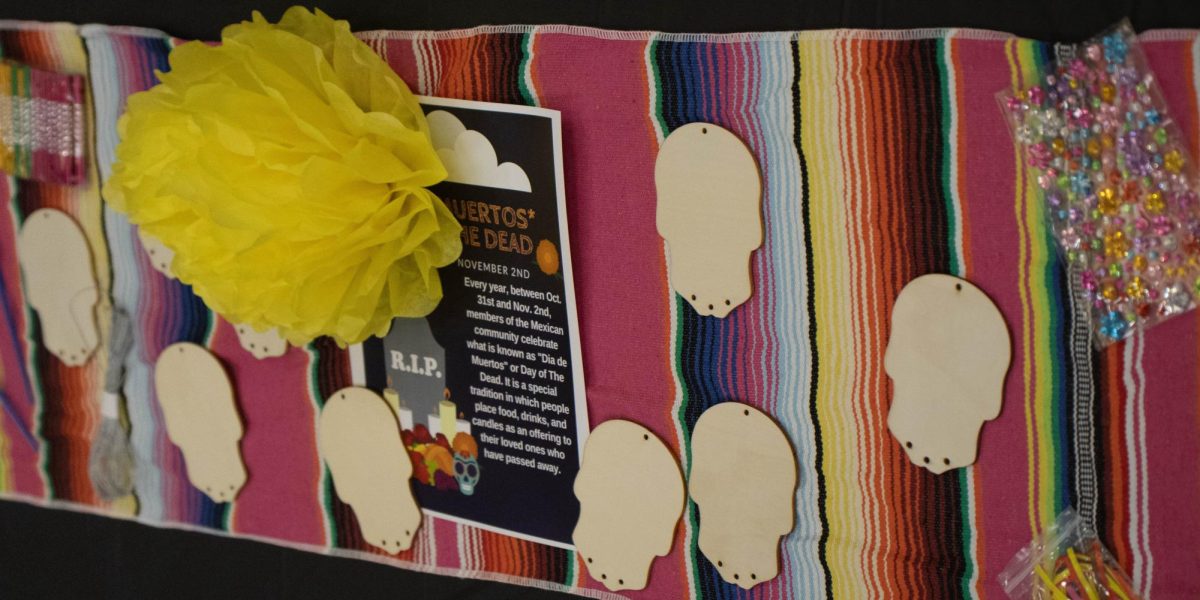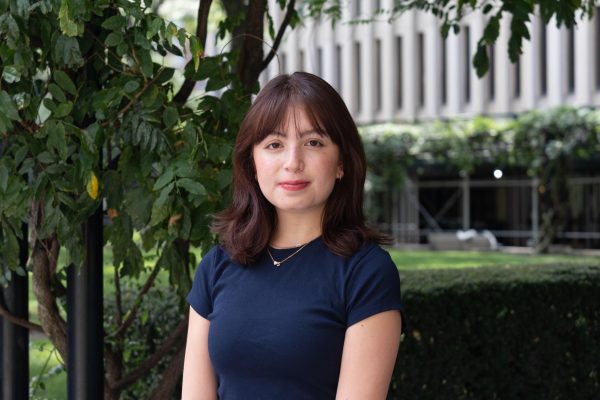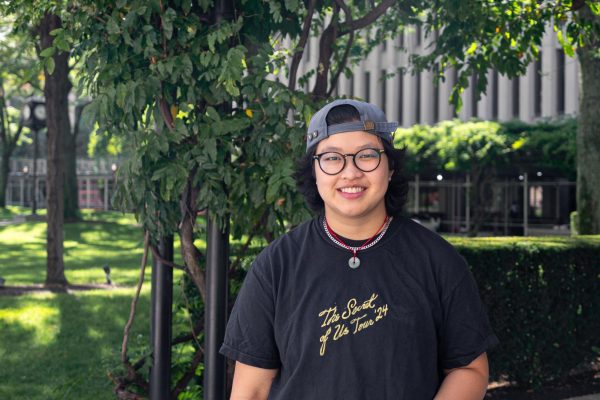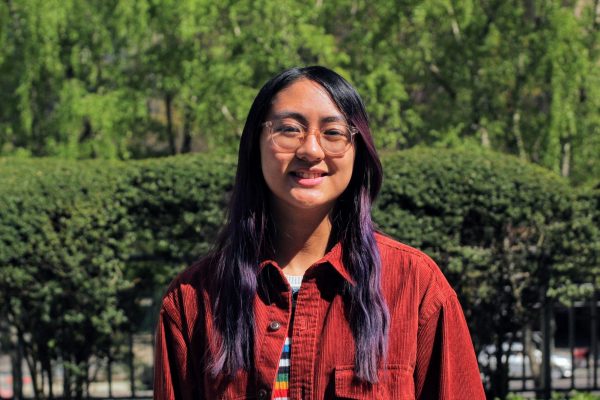On Oct. 31 and Nov. 1, students across both Fordham campuses gathered to celebrate Dia de los Muertos. At Fordham Lincoln Center (FLC), events were hosted by Student Organization of Latines (SOL), the Office of Multicultural Affairs (OMA) and Campus Ministry, who collaborated to create an impassioned and unforgettable event following Mexican tradition.
Dia de los Muertos, or the Day of the Dead, is a period where mourning for death is exchanged for celebration of life. While it originated in Mexico, it is honored across Latin America and now brought right to our campus by FLC’s Latine community. The events held included an ofrenda building, the All Saints’ Day Bilingual Mass and the Dia de los Muertos Celebration.
Beyond its literal translation, Dia de Los Muertos holds meaning to each individual, whether that be a prioritization of tradition, family, friends or community building. Alexandra Pupo, Fordham College at Lincoln Center (FCLC) ’26 and public relations representative for SOL, reflected on the significance of the celebration in her culture.
“Sharing — storytelling — is something that brings people together; food brings people together all the time,” Marie Castro, Vice President of Multicultural Affairs at Fordham Lincoln Center
“I’m Cuban, and a lot of the values that lie under Dia de Muertos are very similar to my values of keeping those people that have passed very near and dear to our hearts because they’re always looking over us,” Pupo said. “As a Catholic, that’s what we’ve always been taught, and we always stay super close to the past and our ancestors because that roots us in who we are.”
Marie Castro, vice president of FLC’s OMA, said that this particular event is able to cultivate important cultural education and experiential learning.
“Sharing — storytelling — is something that brings people together; food brings people together all the time,” Castro said. “I often feel like most of the people in the room typically don’t celebrate Dia de Muertos and they love to learn and they’re open to learning. I think that’s why we continue to do these events, because people are being so open minded and so appreciative of learning about different cultures, of something different from their own.”
“I think there’s a lot of actual hope and camaraderie that comes through in the celebration of recognizing the part of life that grief plays and how we’re not alone in it, and maybe come together as a community.” Erin Hoffman, Director of Campus Ministry at Fordham Lincoln Center
Dia de los Muertos has a range of beautiful traditions to take part in, connecting widespread religious and cultural aspects to more personal values. The cornerstone of this connection, and the most important part of Dia de los Muertos, are the “ofrendas”.
Ofrendas are altars created by families to honor loved ones who have passed. These beautifully colorful and meaningful arrangements are believed to encourage visits from the land of the dead by showing departed souls the path to join the celebrations. SOL members built a vibrant ofrenda altar in St. Rupert Mayer’s chapel on Thursday, setting up pictures of departed loved ones and making space for other offerings to be made over the two-day celebration.
Erin Hoffman, director of Campus Ministry at Fordham Lincoln Center, shared how moving she has found the ofrendas.
“I’m just always really touched by both the individual stories that are shared in submitting things, but then the collective, seeing all of it together and just recognizing that loss and grief and love, are a part of our human experience collectively,” Hoffman said. “I think there’s a lot of actual hope and camaraderie that comes through in the celebration of recognizing the part of life that grief plays and how we’re not alone in it, and maybe come together as a community.”
Those in attendance seemed connected by the significance of both the Catholic holiday and its connection to Dia de los Muertos; these atmospheric qualities created an emotional space, allowing me to reflect on the people in my life by giving me the time to do so.
The altar will be open to any additional offerings for the entire month of November; all are welcome to submit or bring pictures of loved ones to the ofrendas in St. Rupert Mayer’s Chapel. The pictures on the altar create a lovely image of inviting the remembered to rest on a bed of “flor de muerto,” or marigolds.
In the very same chapel on Friday, the All Saints Day Mass was held with both Spanish and English readings. The light streamed through the stained glass windows onto the new ofrendas and filled the room with a quiet comfort. Those in attendance seemed connected by the significance of both the Catholic holiday and its connection to Dia de los Muertos; these atmospheric qualities created an emotional space, allowing me to reflect on the people in my life by giving me the time to do so.
Fabiola Santiago Ruiz, FCLC ’25 and president of SOL, said there is significance in committing time to reconnect with departed loved ones.
“To me, Dia de Los Muertos is about keeping those who you love but have lost close to you. I think it’s a beautiful tradition of just feeling their presence with you,” Ruiz said. “I have lost my grandparents … you think of them throughout the year, but this is a really good day to kind of do that mental exercise and feel them close.”
The presence of a loved one can be kept in many ways. Chelsea Veras, FCLC ’26 and vice president of SOL, shared how she and her family are able to feel connected to those who have passed in day to day life.
“We honor the people that have passed in my family by wearing their favorite colors or having it in the house,” Veras said. “My aunt, who passed a couple years ago, her favorite color was green. And so when me and my family moved, the theme of our house: entirely green … It brings us peace and it makes us feel more connected to my aunt.”
Following the All Saints Day Bilingual Mass was the long-awaited Dia de los Muertos celebration. Members of all parts of the Latine and Fordham community joined SOL, OMA and Campus Ministry over tamales and tacos to celebrate with crafts, music and conversation.
Brianna Perez, a graduate intern and the overseer of the Latine community for OMA, explained their mindset in hosting the celebration.
“But it’s nice to know that a club is able to introduce this holiday to some people that may not know about it, or even students that may be away from home and just create a little place where they could just come and kind of feel connected to what they’re used to.” Valerie Ramirez, FCLC ’28
Perez said, “We believe that celebrating Dia de los Muertos, or this type of event, can help prioritize student voices from different backgrounds and communities, especially in the process to make sure this event remains authentic to them.”
While the lively tunes and the authentic Mexican candy set a festive tone, Michelle Mansilla, FCLC ’28, and Valerie Ramirez, FCLC ’28, said they felt that the event did not quite stir that inspirational or home-like feeling because of the low number of attendees.
“I think now with the food, it’s definitely a homey feeling,” Mansilla said. “I don’t know, right now I just don’t feel a sense of community just because it’s so scattered.”
“Obviously it’s not my family,” Ramirez said. “But it’s nice to know that a club is able to introduce this holiday to some people that may not know about it, or even students that may be away from home and just create a little place where they could just come and kind of feel connected to what they’re used to.”
This reflection highlighted the need for people and community, especially when celebrating those people or communities we may have lost. Regardless of cultural or ethnic background, we are connected by the human experience of both grief and hope, which are intertwined in our embracement of death and life.
These Dia de los Muertos events hosted by SOL, OMA and Campus Ministry are now a Fordham tradition of two years, and will continue to be significant in celebrating Latine culture.
This article is dedicated to my Bà Ba, who we mourn on Oct. 24, but celebrate every day




